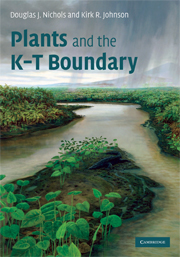Preface
Published online by Cambridge University Press: 22 August 2009
Summary
We both have been fascinated by the Cretaceous–Paleogene (K–T) boundary since the late 1970s. The Alvarez discovery galvanized our individual research efforts and we have worked together on this problem since we met in 1983. Our research has focused on western North America, so our data and interpretations are largely based on field work and laboratory analyses in this region. We have also studied terrestrial K–T boundary sections in Russia, China, and New Zealand and searched, unsuccessfully, for them in Mongolia, Patagonia, and India.
In preparation for writing this book, we made a comprehensive survey of the world's scientific literature through 2006 pertaining to plants and the K–T boundary. Our bibliographic database includes more than 500 references, but we have chosen to cite only those most relevant to understanding the effects of the terminal Cretaceous event on plants. We sought to interpret objectively the data available in those publications rather than simply to repeat the conclusions of the original authors. In many instances we agree with the original authors, but in some we do not. In the latter instances, we trust we have fairly presented their views and that we have given no reason for offense in our reinterpretation.
To present a major conclusion at the outset, we deduce that the changes in plant communities that took place at the K–T boundary are inextricably and causally linked to the impact of an extraterrestrial body on the Earth in the Caribbean region – the Chicxulub impact.
- Type
- Chapter
- Information
- Plants and the K-T Boundary , pp. ix - xPublisher: Cambridge University PressPrint publication year: 2008

